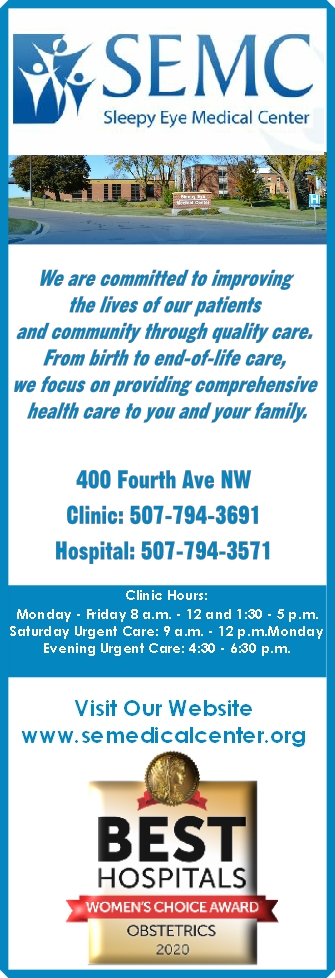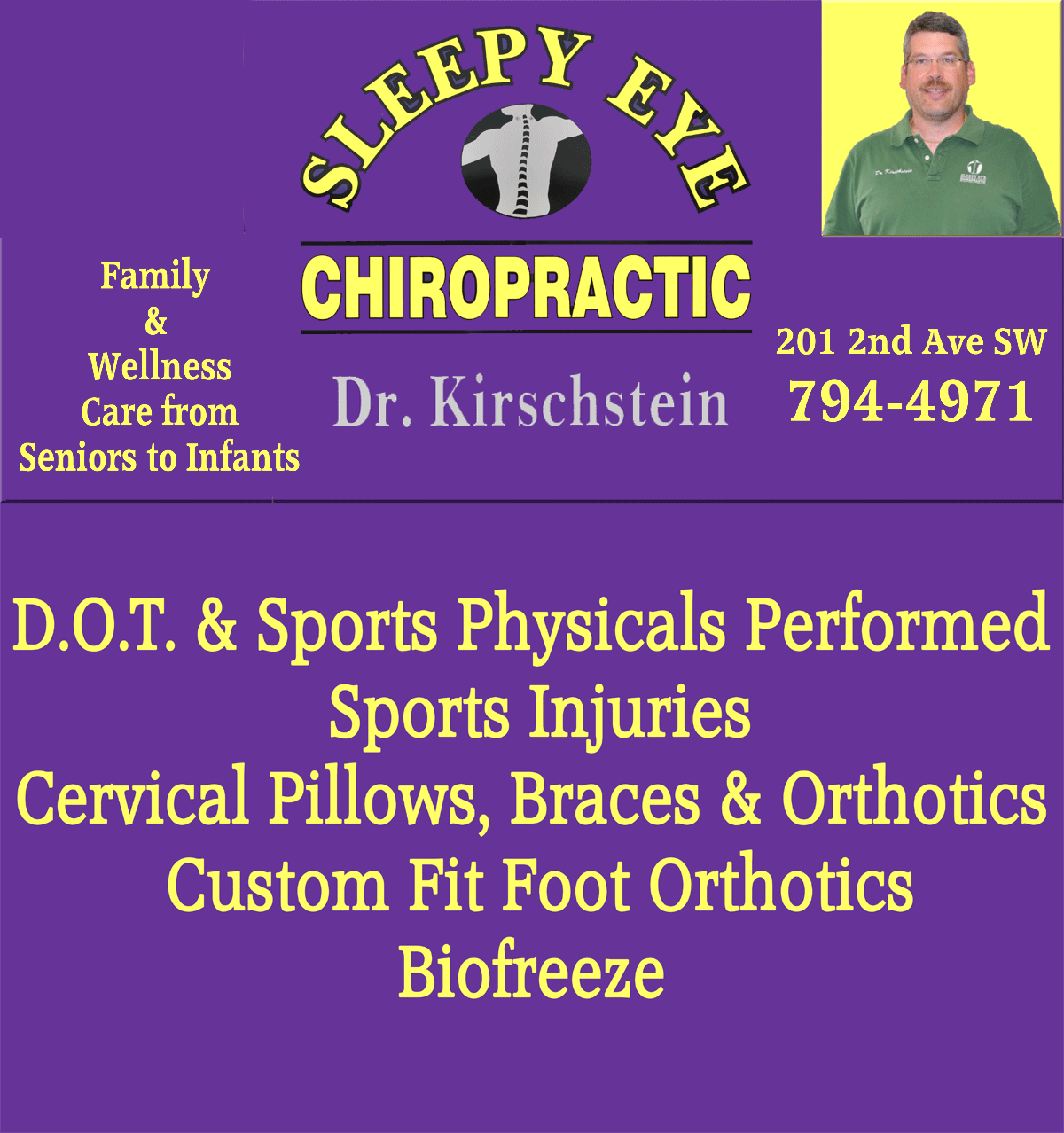by Wayne Pelzel, Sleepy Eye Mayor
The last few weeks have been pretty much dedicated to filling open seats on the City’s various Boards and Commissions. It is the Mayor’s responsibility to appoint people to fill those open seats with approval of the City Council.
Just to give you an awareness of the scope of this, there are 11 active Boards and Commissions. These bodies meet generally monthly and advise the various department heads and make recommendations to the City Council related to their area of expertise. In those 11 boards, there were two openings on the Park Board, two on the Hospital Board, one on the Public Utilities Board, two on the Airport Board, one on the Library Board, one on the Downtown Revitalization Committee, four on the Planning and Zoning Board, one on the Economic Development Authority, one on the Housing and Redevelopment Authority and so on.
It takes a lot of time to touch base with folks who might make good candidates to fill these open seats. Thankfully, at the Jan. 9 meeting of the City Council, approval of this new slate of potential seat holders was on the agenda.
Several people on these Boards who are retiring deserve recognition for their many years of service to the City. The following is a list of people who have served extended periods of time: Gordon Osmonson, 26 years Hospital Board; Darlene Tauer, 25 years Hospital Board; Gregg Tennant, 16 years Park Board; Howard Engholm, 20-plus years Airport Board; Paul Theisen, 22 years Public Utilities Commission.
Thanks to these dedicated folks for their many years of service to the City. Their retirement leaves big shoes to fill.
A new committee is being formed to look into the addition of a daycare facility with the possible addition of a limited recreation center. This committee will look into questions like what facilities might be available now to fulfill this need, funding for a project, and if built, where it should be located and what should be included in it.
The City will end 2023 in great financial condition. The expenditures look to be well under budget. The City has a strong and well placed investment package that provides good returns. Thanks to the City Manager, Bob Elston, for the good work he does in this arena.
Our thanks go out to the hospital administrator, Kevin Sellheim for his 21 years of service to Sleepy Eye Medical Center. May you enjoy a well deserved retirement.
Happy New Year to all. May 2024 be prosperous, successful and filled with peace and joy.
The Community Education Advisory Board will gather on Thursday, September 28, 4 p.m. for the first meeting of the 2023-2024 school year. Advisory Board members offer suggestions and insight in the programs offered through Community Education. They include classes, outings, Driver’s Ed, special events as well as new opportunities.
The fall session of Driver’s Education has already reached the halfway point for classes. The thirty hours are scheduled for Saturday morning and Sunday evenings which seem to fit the schedules of students enrolled. The last session is planned for Sunday, October 15 with the Point of Impact session for parents or guardians held the last part of the class that evening.
“The Lion King” will be presented by the Sleepy Eye High School drama department on October 12, 14 and 15th. Pre-sale reserved seating and general admission tickets may be purchased October 2nd-6th and October 9th-11th from 3:30-5:30 p.m. at the SEHS concession stand. Tickets are also available at the door, one hour prior to performances.
Events planned for the next few weeks include:
All Day Quilting on Saturday, September 30, 8 a.m. to 4 p.m. in the Lindahl Room at Sleepy Eye Elementary School
Early Childhood Screening on Tuesday, October 3 at Trinity Lutheran Church basement
Defensive Driving on Monday, October 9
A fall outing to the Amish at Harmony is planned for Friday, October 13 with registration due October 5. Step back in time and visit Old Order Amish at their farms. The motor coach will journey through the countryside and stop at homes where baked goods, baskets, wood crafts, quilts etc. are for sale. With the leaves getting more colorful, this could be a scenic ride.
The Community Education office is located in Room 109 of the Sleepy Eye High School. School day hours are 8 am to 4 p.m. If the office is unattended, you can call and leave a message on voice mail, 507-794-7873, and we will get back to you with more information. Another option is to email staff with questions and to sign-up: pat.stevermer@sleepyeye.mntm.org or sandy.brinkman@sleepyeye.mntm.org
Gail Gilman, Family Life Consultant, M.Ed., C.F.C.S. and Professor Emeritus, University of Minnesota
“Strategies to Reduce Caregiver Stress” is a three-part series. This column is Part II and will focus on reducing stress through proper nutrition. It includes the following suggestions.
Being overweight (eating too much)
Many people react to stress by eating. Eating too much for a long period causes obesity. This causes your heart and lungs to work harder, overloads your organs and reduces stamina. This in turn leads to illnesses such as heart disease, immune disorders, and diabetes.
Not eating properly
Some people react to stress and stress-induced depression by not eating or eating poorly. If you eat a good, well-balanced diet, your body will be receiving all the nutrients it requires to function properly. On the other hand, if you are eating an unbalanced diet or not eating enough you may be stressing your body and contributing to stress-related complications by depriving yourself of essential nutrients.
Coffee, tea, caffeine soft drinks and chocolate
Caffeine is a stimulant. One of the reasons you probably use it is to raise your level of activity. This chemical actually enhances the stress response and thus increases your existing stress. Small quantities probably do little harm but large quantities over a long period produce excessive stress and lead to many of the physical ailments attributed to chronic stress. Too much caffeine can be dangerous. If you are drinking many cups of caffeine products a day, then you may find you can reduce a lot of stress and save your health by switching to caffeine-free products for a portion of your daily intake.
Alcohol
Some people react to stress by consuming alcohol. In small amounts, spirits may help you relax. In larger amounts alcohol may increase stress as it disrupts sleep. Over the long-term, alcohol will damage your body. Alcohol is also a depressant. If you are prone to depression, alcohol will only make it worse.
Tobacco
In the short-term tobacco use seems to relax people but the toxic effects of nicotine raise the heart rate and enhance the stress response. If you smoke, try taking your pulse before and after a cigarette, and notice the difference. After the initial period of giving up smoking, most ex-smokers report feeling much calmer.
Sugar and refined flour
Sugar can be a stimulant for people experiencing stress and stress-induced depression. Sugar-rich foods (the starch in refined flour is also a form of sugar) can raise your energy level in the short-term. The problem is your body copes with high levels of sugar by secreting large amounts of insulin, which in turn, quickly reduces the excess amount of sugar in your blood stream often causing blood sugar levels to swing too low.
These up and down spikes in blood sugar can cause agitation, mood swings, irritability, and fatigue, which in turn can contribute to the creation of additional stress. The ups and downs of sugar spikes also contribute to depression. And of course, excess sugar is readily converted to body fat thus causing obesity. Consuming sugar in the form of complex carbohydrates such as whole grains, fruits, vegetables, and tubers forces the digestive tract to release blood sugar more slowly and keeps insulin and blood sugar levels more normal. Avoid fruit drinks, sugar drinks, candy, pastas, white bread, and pastries.
Nutritional supplements
There are thousands of supplement suppliers and scores of books that claim success with managing stress by using herbs, herbal extracts or synthesized biochemicals. These compounds often come with the claim of enhancing mood or strengthening the immune system. Since there are so many different competing claims, you must decide for yourself which supplements help and which do not.
If you would like more information on “Strategies to Reduce Caregiver Stress – Part II” contact Gail Gilman, Family Life Consultant, M.Ed., C.F.C.S. and Professor Emeritus –University of Minnesota at waldn001@umn.edu. Be sure to watch for more Family Living Focus™ information in next week’s paper.
Gail Gilman, Family Life Consultant, M.Ed., C.F.C.S. and Professor Emeritus, University of Minnesota
Falls are the leading cause of doctor visits, emergency room visits and hospital admissions. Take these steps to prevent fractures and hopefully you will also prevent falls.
- Do strengthening exercises. It does not matter so much what exercise you choose. Just find something you enjoy and keep doing it, every day, if possible. You will continue to lose bone mass if you do not get active and stay active.
- Get enough calcium. Try to consume as much calcium as possible in food and take calcium supplements if your doctor advises.
- Get enough Vitamin D. To absorb calcium, our bodies need Vitamin D.
- Get enough protein. Skeletal muscle serves as a storage place for protein in the body
- Talk with your doctor about new methods that are being developed for preventing fractures.
Even if you have never lost your balance or tripped and fallen, simply being afraid of falling can affect your quality of life. That fear can make you less confident, more depressed, and even more isolated from others.
Begin by making your home “fall-proof” with these steps.
- Remove things you can trip over, such as papers, books, clothes, shoes.
- Remove small throw rugs or use non-slip liners underneath rugs to keep them from slipping.
- Keep items you use often in cabinets you can reach easily without using a step stool.
- Have grab bars installed by a professional next to your toilet and in the tub or shower.
- Use non-slip mats in the bathtub and shower.
- Improve lighting in your home. As we get older, we need brighter lights and less glare to see well.
- Have handrails and lights installed on all staircases.
- Wear shoes that give good support and that have thin, non-slip soles. Avoid slippers and athletic shoes with deep treads.
If you would like more information on “Fall-Proof your Home to contact Gail Gilman, Family Life Consultant, M.Ed., C.F.C.S. and Professor Emeritus – University of Minnesota at waldn001@umn.edu. Be sure to watch for more Family Living Focus™ information in next week’s paper.
Gail Gilman, Family Life Consultant, M.Ed., C.F.C.S. and Professor Emeritus, University of Minnesota
What dairy foods should I eat or drink if I am lactose intolerant?
Lactose intolerance does not have to mean dairy food avoidance. In fact, research shows that many individuals who are lactose intolerant can enjoy the recommended three servings of dairy foods daily.
Lactose intolerance is not an allergy, but an intolerance to the naturally occurring sugar lactose in milk. Most people who have it can enjoy dairy foods by drinking lactose-free milk, small amounts of regular milk, or including natural cheeses and yogurt in their diet. Lactose-free milk is real milk, just without the lactose. Yogurt, with live and active cultures, contains friendly bacteria and enzymes which help digest lactose. Aged cheeses are naturally low in lactose.
Why is milk pasteurized and what is pasteurization?
French doctor and scientist Louis Pasteur invented the process of pasteurization more than a century ago. Pasteurization is the process of heating milk to at least 161° Fahrenheit for 15 seconds to remove milk-borne pathogens. This simple process destroys harmful bacteria while maintaining milk’s quality, taste, and nutritional value. Since its discovery, pasteurization has safeguarded much of our food supply, including milk and dairy products. By heating raw milk in specially designed equipment, pasteurization ensures the safety and wholesomeness of milk.
Cow’s milk, a quality protein source, is made up of primarily whey and casein proteins. Whey protein is a high-quality protein. Compared to many other proteins, on a gram-to-gram basis, whey protein delivers more essential amino acids to the body and is absorbed quickly and efficiently.
According to the United Nations Food Agriculture Organization and the World Health Organization, probiotics are “live microorganisms, which when administered in adequate amounts, confer a health benefit on the host.” Traditionally, these “friendly bacteria” were found in fermented foods such as yogurt and cultured milk but can now be found as an added ingredient in milk and cheese as well. Some strains of probiotics have been associated with digestive health, while others may benefit the immune system. The science on probiotics is new and evolving, so no definitive conclusions about their benefits can be determined yet.
How do I store dairy foods?
Milk
- Refrigerate milk at 40°F or less as soon as possible after purchase and store in the original container.
- Return milk to the refrigerator immediately after pouring.
- Store milk in the coldest part of the refrigerator, which tends to be toward the back.
- Never return unused milk to the original container.
- Protect milk from exposure to strong light since light can reduce its riboflavin content and cause off-flavors.
Cheese
- Keep cheese at a temperature at or below 40° F.
- Wrap hard cheeses, such as cheddar, Gouda, Edam, and Swiss, in an inner layer of wax or parchment paper and an outer layer of plastic wrap to help maintain freshness.
- Generally, harder (low-moisture) cheeses keep longer in the refrigerator than softer (higher-moisture) cheeses.
Yogurt
- Yogurt should be stored in closed containers in the refrigerator at 40° F to maintain its quality.
- Store yogurt for one to two weeks after buying it. Prolonged refrigeration of yogurt should be avoided as yogurt bacteria tend to decrease in viability and numbers over time.
Butter
- To preserve butter’s flavor and freshness, refrigerate opened butter in a covered dish in the butter compartment.
- Unopened, wrapped butter may be stored in the refrigerator for up to two months.
Cream
- Keep it refrigerated in its closed container at 40° F or lower. Heavy cream should be used within 10 days, while half and half should be consumed within 4 days.
- Ultra-pasteurized cream keeps up to 1 month, but once opened, it should be used within 1 week.
What does the “Sell By” date mean?
Every carton of milk sold in the United States is clearly labeled with a “sell by,” “pull,” “use by” or “best if used by” date. Each of these dates means something different. The “sell by” and “pull” dates refer to how long a grocery store can keep the product in the dairy case. The product must be sold by the date labeled on the package. This date considers time for the food to be used at home, so you should buy the product before the “sell by” or “pull” date, but you do not have to use it by then.
Yes and no, each dairy product is a bit different:
Milk
Milk can be frozen, but it is not preferred. Freezing changes the texture and appearance of milk. Freezing milk does not harm the milk but disturbs the quality in taste and consistency.
Cheese
Cheese can be frozen, but it may become mealy and crumbly when thawed. Thawed cheese is best used crumbled or shredded in salads, as toppings or in cooked dishes. Some cheeses are better frozen than others. Because blue cheese varieties like Roquefort and Gorgonzola are generally used crumbled, further change in their texture is of little consequence. Because other cheeses like Parmesan and Romano can be stored in the refrigerator for prolonged periods, freezing is unnecessary.
When freezing cheese, freeze quickly and store at 0º F or lower. Thaw in the refrigerator and use as soon as possible after thawing.
If you would like more information on “June Dairy Month Questions” feel free to contact Gail Gilman, Family Life Consultant, M.Ed., C.F.C.S. and Professor Emeritus – University of Minnesota at waldn001@umn.edu. Be sure to watch for more Family Living Focus™ information in next week’s paper.
Gail Gilman, Family Life Consultant, M.Ed., C.F.C.S. and Professor Emeritus, University of Minnesota
Many diseases and conditions can be prevented or controlled if they are caught early. The following information will help you decide what tests you need and how often you need them. Keep track of these tests by recording them on a checkup and test record sheet.
High Blood pressure
High blood pressure can lead to heart disease, stroke, and kidney disease. It is most common in black people and people older than age 45.
Eating a healthy diet and being active are two ways you can keep your blood pressure under control.
Some people need to take medicine to keep their blood pressure at healthy levels. If you take medicine, be sure to talk to your doctor about how to take it. Do not skip any doses of medicine.
Ask your doctor or nurse:
- What should my blood pressure be?
- How often should I have my blood pressure checked?
- If I have high blood pressure, what can I do to lower it?
High Cholesterol
Too much cholesterol can clog your blood vessels and is a major cause of heart disease.
To help lower your cholesterol and keep it at a healthy level, eat the right foods, maintain a healthy weight, and be physically active. Your doctor or nurse may suggest you take medicine to lower your cholesterol.
For persons 50 or older have your cholesterol checked. Most experts recommend checking it every 5 years. Your doctor or nurse may suggest you have it checked more often, especially if your cholesterol is too high.
Ask your doctor or nurse:
- How often should I have my cholesterol checked?
- What is a healthy cholesterol level for me?
- If I have high cholesterol, what can I do to lower it?
If you would like more information on “Tests to Find Diseases or Conditions Early” feel free to contact Gail Gilman, Family Life Consultant, M.Ed., C.F.C.S. and Professor Emeritus – University of Minnesota at waldn001@umn.edu. Be sure to watch for more Family Living Focus™ information in next week’s paper.
Oh boy, slow down. I am excited that it is finally nice out too. I can’t wait to have a couple of days off to enjoy
the weather. However, last weekend I worked and I can tell everyone is feeling good because the average speed in town
rose notably.
We always see an uptick this time of year. Winter is over and it feels like a weight is lifted off us. With the nice
weather comes many people and kids walking and playing around the street. I get it, I feel like driving fast as well, but
we can’t. As the weather gets nicer if anything we need to slow down a bit.
The speed isn’t horrendous overall but suddenly I am seeing a lot of 34 and 35 miles per hour. Does anyone honestly
think driving 4 to 5 miles over the limit saves that much time? In Sleepy Eye, a little faster maybe saves you a minute from one side of town to the other. One minute against the safety of a human life.
I believe that people are not knowingly going faster, it is just happening due to the feeling of spring’s freedom from winter. Since we are not consciously going faster, we need to consciously slow down for safety. Please take the time to think about this and realize that 30 is fast enough. If you ask me, I think 30 on a side street is way too fast. It is easy to forget the impact of speed. Rarely does anything bad happen other than a possible ticket. The real impact is the death of a
person.
I would love to go through my career without having to again explain to a family member that their loved one isn’t
coming home because of an accident. Accident or not, driving a vehicle that kills someone is something that will stay
with you forever.
Hardly worth saving a minute.











